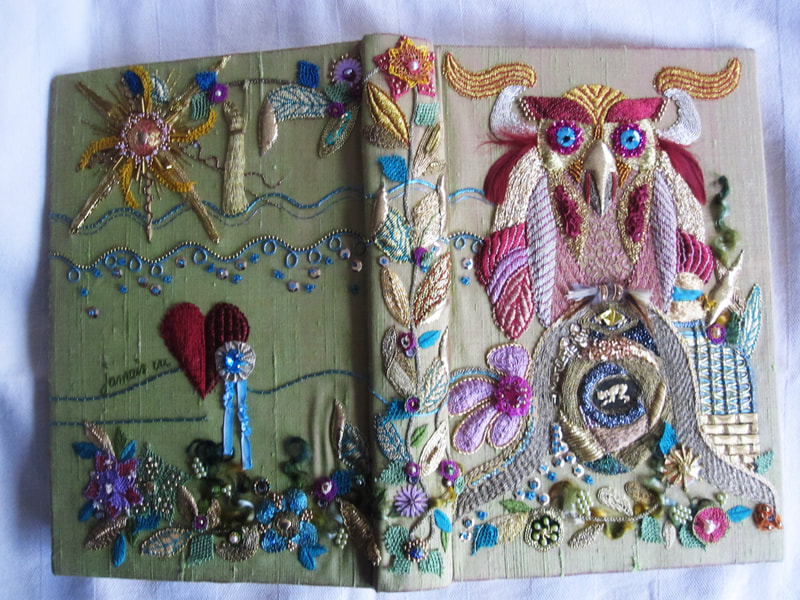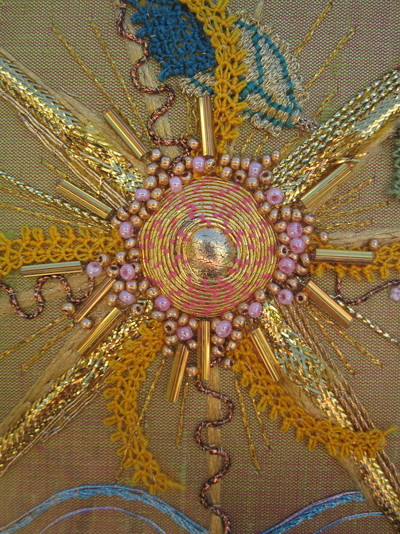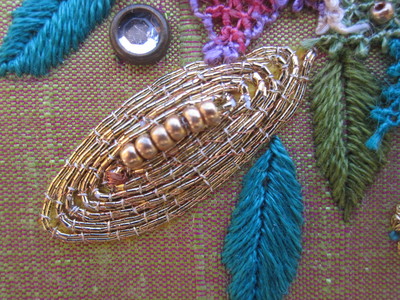GEBORDUURDE BOEKBANDEN
Rare books, handmade with embroidered covers
Een aantal jaren geleden bedacht ik hoe leuk het kan zijn om een boek te voorzien van een geborduurde band.
Ik had prachtige exemplaren gezien in de Koninklijke Bibliotheek (KB) in Amsterdam en wilde een dergelijk boek zelf kunnen maken.
Ik nam lessen in de kunst van het handboekbinden en leerde dat elke bindwijze maar zeker ook elk materiaal specifieke behandeling vraagt. Na een aantal jaren heb ik in 2015 mijn vorderingen laten zien tijdens de Biennale in de kunst van het handboekbinden in St Remy de Chevreuse dichtbij Parijs.
Daarna maakte ik meer geborduurde boekbanden in 2017, 2018, 2019, 2020, 2023.
A few years ago I tought how nice it would be to create a book with embroidery on the cover of the book. I had seen beautiful examples in the Royal Library in Amsterdam (KB) and wanted to be able to make such a book myself. I took lessons in the art of bookbinding and learned that every method of binding, and certainly every material requires specific treatment. After a number of years I was able to show my progress during the Biennales Mondiales in the art of handbook binding in St Remy de Chevreuse near Paris in 2015.
Then I made more embroidered book bindings.
Rare books, handmade with embroidered covers
Een aantal jaren geleden bedacht ik hoe leuk het kan zijn om een boek te voorzien van een geborduurde band.
Ik had prachtige exemplaren gezien in de Koninklijke Bibliotheek (KB) in Amsterdam en wilde een dergelijk boek zelf kunnen maken.
Ik nam lessen in de kunst van het handboekbinden en leerde dat elke bindwijze maar zeker ook elk materiaal specifieke behandeling vraagt. Na een aantal jaren heb ik in 2015 mijn vorderingen laten zien tijdens de Biennale in de kunst van het handboekbinden in St Remy de Chevreuse dichtbij Parijs.
Daarna maakte ik meer geborduurde boekbanden in 2017, 2018, 2019, 2020, 2023.
A few years ago I tought how nice it would be to create a book with embroidery on the cover of the book. I had seen beautiful examples in the Royal Library in Amsterdam (KB) and wanted to be able to make such a book myself. I took lessons in the art of bookbinding and learned that every method of binding, and certainly every material requires specific treatment. After a number of years I was able to show my progress during the Biennales Mondiales in the art of handbook binding in St Remy de Chevreuse near Paris in 2015.
Then I made more embroidered book bindings.
2015 'Vendredi ou la Sauvage' - Michel Tournier met illustraties van Claire Illouz
Op een groene zijde borduurde ik, in reliëf, een door mijzelf gemaakt ontwerp dat geïnspireerd is op het verhaal van Michel Tournier.
De toegepaste technieken zijn de traditionele goud borduurtechnieken en met gebruik van ook eigentijds materiaal.
Er is gekozen voor een Franse binding zodat de kneep niet zichtbaar werd aan de buitenkant van het boek.
De techniek Igne Oyalari (oud Ottomaanse knoopkant) is met name toegepast in de florale ornamenten.
De naam Igne Oyalari werd in Parijs gezien als de naam van een persoon. Om die reden werd het boek gediskwalificeerd in de competitie. Het boek zou niet door 1 persoon gemaakt zijn....
On a green silk I embroidered in relief a design I made myself that is inspired by the story of Michel Tournier.
The techniques used are the traditional gold embroidery techniques with traditional and also with contemporary material.
The Igne Oyalari technique (old Ottoman knot lace) is mainly used in the floral ornaments.
The name Igne Oyalari was seen in Paris as the name of a person. For that reason, the book was disqualified from the competition. The book would not have been made by 1 person....
Op een groene zijde borduurde ik, in reliëf, een door mijzelf gemaakt ontwerp dat geïnspireerd is op het verhaal van Michel Tournier.
De toegepaste technieken zijn de traditionele goud borduurtechnieken en met gebruik van ook eigentijds materiaal.
Er is gekozen voor een Franse binding zodat de kneep niet zichtbaar werd aan de buitenkant van het boek.
De techniek Igne Oyalari (oud Ottomaanse knoopkant) is met name toegepast in de florale ornamenten.
De naam Igne Oyalari werd in Parijs gezien als de naam van een persoon. Om die reden werd het boek gediskwalificeerd in de competitie. Het boek zou niet door 1 persoon gemaakt zijn....
On a green silk I embroidered in relief a design I made myself that is inspired by the story of Michel Tournier.
The techniques used are the traditional gold embroidery techniques with traditional and also with contemporary material.
The Igne Oyalari technique (old Ottoman knot lace) is mainly used in the floral ornaments.
The name Igne Oyalari was seen in Paris as the name of a person. For that reason, the book was disqualified from the competition. The book would not have been made by 1 person....
llustraties in het boek heb ik uit de pagina's gesneden en 'opgehangen' in perkament (perkament). Ik gebruikte naadverbindingen die werden gebruikt in huishoudtextiel of in kleding, al dan niet decoratief.
Illustrations in the book I cut out of the pages and 'hung' in parchment (vellum). I used seam joints that were used in household textiles or in clothing, whether decorative or not.
Illustrations in the book I cut out of the pages and 'hung' in parchment (vellum). I used seam joints that were used in household textiles or in clothing, whether decorative or not.
2017 L'Art d'etre Grand-Pere -Victor Hugo
2018 Uitvreter - Titaantjes - Dichtertje door Nescio
Beoordeeld op Koppermaandag 2019 - de bindingen wonnen de 2e prijs.
Het boekblok werd door Rob Koch (Atelier De Ganzenweide) verdeeld in drie aparte boeken met doorlopende paginanummering.
Dat maakte het voor mij mogelijk de drie verhalen elk een band te geven.
Het foedraal, in de vorm van een boek met klampslot (been), houdt de drie boekjes bijeen.
Het borduurwerk op elk van de boekjes correspondeert met het schutblad dat elk boekje heeft.
This book was reviewed in The Hague - The Netherlands on Koppermaandag 2019 - and won the 2nd prize in the competition.
The bookblock was divided by Rob Koch (Atelier De Ganzenweide) into three separate books with sequential pagenumbering.
That made it possible for me to give the three stories each its own binding.
The sheath, in the form of a book with a clinglock (bone), holds the three books together.
The embroidery on each of the booklets corresponds to the endpaper that each booklet has.
Beoordeeld op Koppermaandag 2019 - de bindingen wonnen de 2e prijs.
Het boekblok werd door Rob Koch (Atelier De Ganzenweide) verdeeld in drie aparte boeken met doorlopende paginanummering.
Dat maakte het voor mij mogelijk de drie verhalen elk een band te geven.
Het foedraal, in de vorm van een boek met klampslot (been), houdt de drie boekjes bijeen.
Het borduurwerk op elk van de boekjes correspondeert met het schutblad dat elk boekje heeft.
This book was reviewed in The Hague - The Netherlands on Koppermaandag 2019 - and won the 2nd prize in the competition.
The bookblock was divided by Rob Koch (Atelier De Ganzenweide) into three separate books with sequential pagenumbering.
That made it possible for me to give the three stories each its own binding.
The sheath, in the form of a book with a clinglock (bone), holds the three books together.
The embroidery on each of the booklets corresponds to the endpaper that each booklet has.
2019 Pallieter -Felix Timmermans
Beoordeeld op Koppermaandag 2020 door een vakjury op initiatief van 't Ambachtshuis in Den Haag. De binding won de 1e prijs.
(Koppermaandag is de eerste maandag na Driekoningen, van oudsher een feestdag voor de gilden.)
Judged on Koppermaandag 2020 by a professional jury on the initiative of 't Ambachtshuis in The Hague. The binding won the 1st prize.
(Koppermaandag is the first Monday after Epiphany, traditionally a holiday for the guilds.)
Voor het borduursel maakte ik een tekening naar het beeld dat in Iper (Belgie) te zien is. De tekening is 'vrij' geborduurd in lijntjes zoals een etser tekent. De ondergrond is een linnen met een print van het modehuis Marimekko - Finland.
For the embroidery I made a drawing after the statue that can be seen in Iper (Belgium). The drawing is 'freely' embroidered in lines like an etcher draws. The background is a linen with a print from the fashion house Marimekko - Finland.
Beoordeeld op Koppermaandag 2020 door een vakjury op initiatief van 't Ambachtshuis in Den Haag. De binding won de 1e prijs.
(Koppermaandag is de eerste maandag na Driekoningen, van oudsher een feestdag voor de gilden.)
Judged on Koppermaandag 2020 by a professional jury on the initiative of 't Ambachtshuis in The Hague. The binding won the 1st prize.
(Koppermaandag is the first Monday after Epiphany, traditionally a holiday for the guilds.)
Voor het borduursel maakte ik een tekening naar het beeld dat in Iper (Belgie) te zien is. De tekening is 'vrij' geborduurd in lijntjes zoals een etser tekent. De ondergrond is een linnen met een print van het modehuis Marimekko - Finland.
For the embroidery I made a drawing after the statue that can be seen in Iper (Belgium). The drawing is 'freely' embroidered in lines like an etcher draws. The background is a linen with a print from the fashion house Marimekko - Finland.
2020 Van den Vos - Reynaerde (uitgave Stichting Handboekbinden/Atelier De Ganzenweide)
Dit boek heb ik op Middeleeuwse wijze gebonden in perkament.
In het perkament van het voorplat werd een gat gemaakt waarin een borduursel -vos met (geitenhaar) staart- met gouddraden is vastgezet.
Oude voorbeelden laten zien dat gaten in perkament in het verleden ook werden gevuld met textiel.
Veelal waren het stukjes naaldkant, gemaakt met bontgekleurde zijde dat in het gat, soms midden op de pagina met tekst, werd aangebracht.
This book I bounded in vellum in the medieval way.
A hole was made in the parchment of the front cover in which an embroidery - fox with (goat's hair) tail - was fixed with gold threads.
Ancient examples show that holes in parchment were also filled with textiles.
Often it was with needle lace, made with brightly colored silk that was applied in the hole, sometimes even in the middle of the page in between text.
Dit boek heb ik op Middeleeuwse wijze gebonden in perkament.
In het perkament van het voorplat werd een gat gemaakt waarin een borduursel -vos met (geitenhaar) staart- met gouddraden is vastgezet.
Oude voorbeelden laten zien dat gaten in perkament in het verleden ook werden gevuld met textiel.
Veelal waren het stukjes naaldkant, gemaakt met bontgekleurde zijde dat in het gat, soms midden op de pagina met tekst, werd aangebracht.
This book I bounded in vellum in the medieval way.
A hole was made in the parchment of the front cover in which an embroidery - fox with (goat's hair) tail - was fixed with gold threads.
Ancient examples show that holes in parchment were also filled with textiles.
Often it was with needle lace, made with brightly colored silk that was applied in the hole, sometimes even in the middle of the page in between text.
2023/2024 Sunny Boy - Annejet van der Zijl - uitgave Heel Nederland leest -CPNB
Dit boek was te zien in de OBA (Openbare Bibliotheek Amsterdam) Oosterdok van 03-05-2024 tot 01-07-2024 samen met nog ruim 80 andere handgemaakte boekbanden (Chalenge - Stichting Handboekbinden Nederland)
This book was on display in the OBA (Public Library Amsterdam) Oosterdok from 03-05-2024 to 01-07-2024 together with more than 80 other handmade bookbindings (Chalenge 2023 - Stichting Handboekbinden Nederland)
Dit boek was te zien in de OBA (Openbare Bibliotheek Amsterdam) Oosterdok van 03-05-2024 tot 01-07-2024 samen met nog ruim 80 andere handgemaakte boekbanden (Chalenge - Stichting Handboekbinden Nederland)
This book was on display in the OBA (Public Library Amsterdam) Oosterdok from 03-05-2024 to 01-07-2024 together with more than 80 other handmade bookbindings (Chalenge 2023 - Stichting Handboekbinden Nederland)
Mijn bijdrage aan de chalenge heeft een ’geheime schildering’ op de voorsnede onder het goud. Het zijn landschapjes; links Nederland en rechts Suriname, die met elkaar worden verbonden door een boom die links loof- en rechts palmboom is. Dat thema vind je terug op het voorplat van de geborduurde boekband.
Ik heb gewerkt met de technieken én materialen van het goudborduren. Daarnaast heb ik een oude Ottomaanse naaldkanttechniek gebruikt, het zogenaamde Igne Oyalari.
De ondergrond is een zijden damast waarin de zwarte flora de tragiek van het verhaal symboliseert.
Op het achterplat heb ik, op een vlekkerig lapje katoen, de woorden geborduurd die Rika tijdens haar deportatie schreef in de trein. Een schril contrast met het goudwerk.
Zon en maan staan symbool voor het goed en kwaad.
Ik draag dit werk op aan mijn vader die na de oorlog (1940-1945) thuiskwam in de overtuiging dat er in alle volkeren goed en kwaad zit.
My contribution to the chalenge has a 'secret painting' on the front cut under the gold. It shows two landscapes; The Netherlands on the left and Suriname on the right. Both are connected by a tree that is a deciduous tree on the left an olm and a palmtree on the right. This theme can be found on the front cover of the book too.
I have worked with the techniques and materials of goldembroidery. In addition, I used an old Ottoman needle lace technique, the so-called Igne Oyalari.
The background is a silk damask in which the black flora symbolizes the tragedy of the story.
On the back cover, on a smudged piece of cotton, I embroidered the words that Rika wrote on the train during her deportation. A stong contrast to the goldwork.
Sun and moon symbolize good and evil.
I dedicate this work to my father who came home after the war (1940-1945) convinced that there is good and evil in all peoples.
Ik heb gewerkt met de technieken én materialen van het goudborduren. Daarnaast heb ik een oude Ottomaanse naaldkanttechniek gebruikt, het zogenaamde Igne Oyalari.
De ondergrond is een zijden damast waarin de zwarte flora de tragiek van het verhaal symboliseert.
Op het achterplat heb ik, op een vlekkerig lapje katoen, de woorden geborduurd die Rika tijdens haar deportatie schreef in de trein. Een schril contrast met het goudwerk.
Zon en maan staan symbool voor het goed en kwaad.
Ik draag dit werk op aan mijn vader die na de oorlog (1940-1945) thuiskwam in de overtuiging dat er in alle volkeren goed en kwaad zit.
My contribution to the chalenge has a 'secret painting' on the front cut under the gold. It shows two landscapes; The Netherlands on the left and Suriname on the right. Both are connected by a tree that is a deciduous tree on the left an olm and a palmtree on the right. This theme can be found on the front cover of the book too.
I have worked with the techniques and materials of goldembroidery. In addition, I used an old Ottoman needle lace technique, the so-called Igne Oyalari.
The background is a silk damask in which the black flora symbolizes the tragedy of the story.
On the back cover, on a smudged piece of cotton, I embroidered the words that Rika wrote on the train during her deportation. A stong contrast to the goldwork.
Sun and moon symbolize good and evil.
I dedicate this work to my father who came home after the war (1940-1945) convinced that there is good and evil in all peoples.































